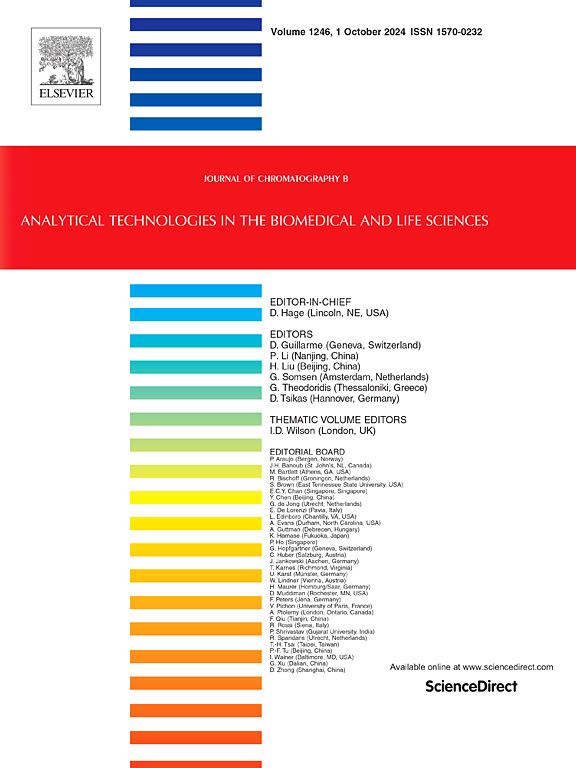Screening biomarkers for diagnosis of COPD by multiplex-high-resolution mass spectrometry based pseudotargeted lipidomics
IF 2.8
3区 医学
Q2 BIOCHEMICAL RESEARCH METHODS
引用次数: 0
Abstract
Triple quadrupole (QQQ) MS based pseudotargeted lipidomics combines high coverage and quantitative accuracy, is commonly established by selecting the most responsive lipid ion pairs identified from high-resolution mass spectrometry (HRMS), then sending them to QQQ MS for quantification by multiple reaction monitoring. Due to the low resolution of QQQ MS, it may result in faulty peak identification in integration and method transition from HRMS to QQQ MS, thus, directly establish pseudotargeted lipidomics on HRMS is needed to improve the accuracy of present methods. We propose a method for rapidly screening high-resolution ion pairs for constructing multiplex-HRMS-based pseudotargeted lipidomics (MHPL). Firstly, high-resolution precursor and product ions for lipid quantification were obtained by HRMS. To solve the problem of lower acquisition speed in HRMS, we used the multiplex mode to simultaneously fragment co-eluting lipid precursor ions within one isolation window, scan the MS/MS mass spectra, and quantify the unique product ions (UPI) of co-eluting lipid (defined as Quan-PIs). Meanwhile, we provide a group of scripts for searching for lipid Quan-PIs in multiplex mode. The proposed MHPL strategy could ensure accurate quantification of 460 lipids within 5 injections, and was applied in serum differential lipid discovery for chronic obstructive pulmonary disease (COPD) patients. As a result, 47 differential lipids were found to comprise a potential biomarker panel for COPD diagnosis. The lipid identification and quantification in this work were conducted in the same instrument, and faulty peak identification was considerably reduced in integration and when transitioning methods from HRMS to QQQ MS.
基于多分辨率质谱的假靶向脂质组学筛选COPD诊断的生物标志物
基于三重四极杆(QQQ)质谱的伪靶向脂质组学具有高覆盖率和定量准确性,通常通过选择高分辨率质谱(HRMS)鉴定的最敏感的脂质离子对,然后将其发送到QQQ质谱进行多反应监测定量来建立。由于QQQ质谱的分辨率较低,在整合过程中可能出现峰识别错误,方法从HRMS过渡到QQQ质谱,因此需要在HRMS上直接建立伪靶向脂质组学,以提高现有方法的准确性。我们提出了一种快速筛选高分辨率离子对的方法,用于构建基于多重hrms的假靶向脂质组学(MHPL)。首先,利用HRMS获得了高分辨率的脂质定量前体和产物离子;为了解决HRMS采集速度较慢的问题,我们采用多重模式在一个分离窗口内同时对共洗脱脂质前体离子进行片段化,扫描MS/MS质谱,并定量共洗脱脂质的唯一产物离子(UPI)(定义为quan - pi)。同时,我们提供了一组多路搜索脂质全pi的脚本。所提出的MHPL策略可确保在5次注射内准确定量460种脂质,并应用于慢性阻塞性肺疾病(COPD)患者的血清脂质鉴别发现。结果,发现47种不同的脂质组成了COPD诊断的潜在生物标志物面板。本工作中的脂质鉴定和定量在同一台仪器上进行,在整合和从HRMS过渡到QQQ MS时,大大减少了错误峰鉴定。
本文章由计算机程序翻译,如有差异,请以英文原文为准。
求助全文
约1分钟内获得全文
求助全文
来源期刊

Journal of Chromatography B
医学-分析化学
CiteScore
5.60
自引率
3.30%
发文量
306
审稿时长
44 days
期刊介绍:
The Journal of Chromatography B publishes papers on developments in separation science relevant to biology and biomedical research including both fundamental advances and applications. Analytical techniques which may be considered include the various facets of chromatography, electrophoresis and related methods, affinity and immunoaffinity-based methodologies, hyphenated and other multi-dimensional techniques, and microanalytical approaches. The journal also considers articles reporting developments in sample preparation, detection techniques including mass spectrometry, and data handling and analysis.
Developments related to preparative separations for the isolation and purification of components of biological systems may be published, including chromatographic and electrophoretic methods, affinity separations, field flow fractionation and other preparative approaches.
Applications to the analysis of biological systems and samples will be considered when the analytical science contains a significant element of novelty, e.g. a new approach to the separation of a compound, novel combination of analytical techniques, or significantly improved analytical performance.
 求助内容:
求助内容: 应助结果提醒方式:
应助结果提醒方式:


